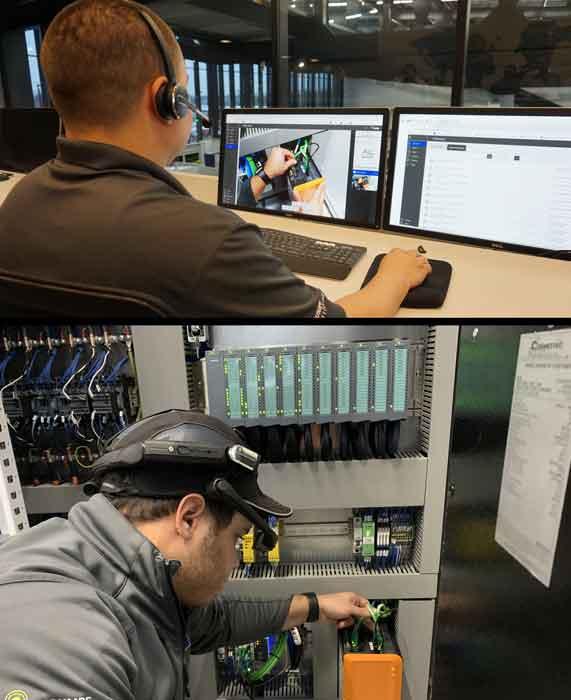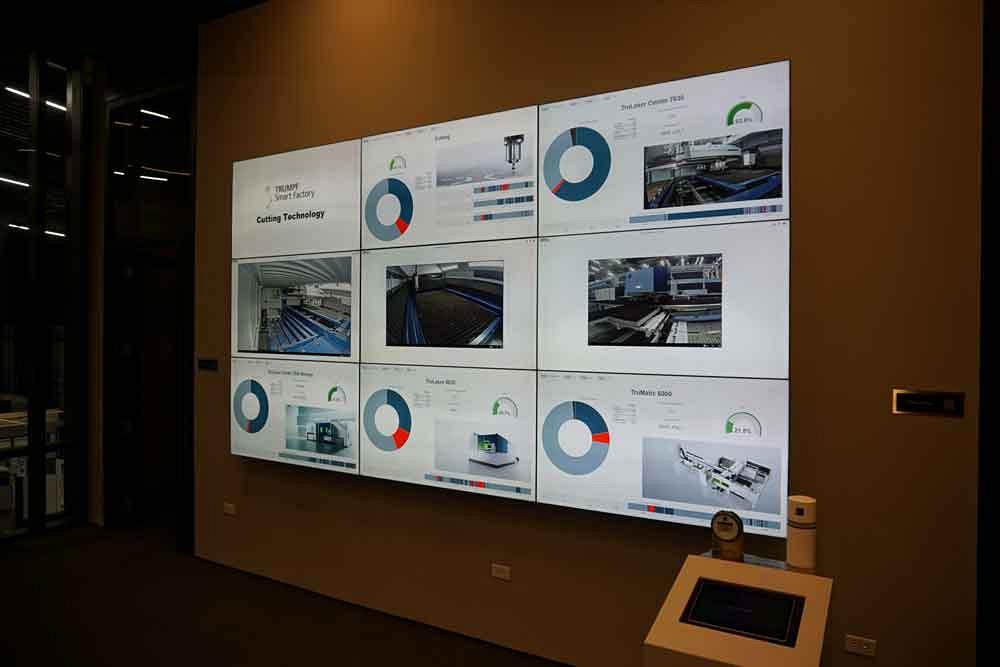Director, TRUMPF Smart Factory
- FMA
- The Fabricator
- FABTECH
- Canadian Metalworking
Categories
- Additive Manufacturing
- Aluminum Welding
- Arc Welding
- Assembly and Joining
- Automation and Robotics
- Bending and Forming
- Consumables
- Cutting and Weld Prep
- Electric Vehicles
- En Español
- Finishing
- Hydroforming
- Laser Cutting
- Laser Welding
- Machining
- Manufacturing Software
- Materials Handling
- Metals/Materials
- Oxyfuel Cutting
- Plasma Cutting
- Power Tools
- Punching and Other Holemaking
- Roll Forming
- Safety
- Sawing
- Shearing
- Shop Management
- Testing and Measuring
- Tube and Pipe Fabrication
- Tube and Pipe Production
- Waterjet Cutting
Industry Directory
Webcasts
Podcasts
FAB 40
Advertise
Subscribe
Account Login
Search
Industry 4.0 and the small shop: Reshaping sheet metal manufacturing
Metal fabricators can prepare by adopting the technology one step at a time
- By Markus Zimmermann
- March 3, 2020
- Article
- Shop Management
Industry 4.0. You see the term everywhere, in consumer media, conferences, tradeshows. You hear about the fourth industrial revolution, about manufacturing entering a new era. It all sounds grand and glorious, but what does it all really mean?
To start, imagine a sheet metal shop—not a large operation, but one with, say, a few dozen employees. It looks normal enough at first, but then some oddities stand out. Each cart carrying a job on the floor has a small puck device that seems to be communicating with shop software; a large monitor overhead shows a shop floor map that reveals exactly where each job stands.
Then you see the office. People study 3D models that customers uploaded to a web-based quoting system. It turns out that most people are viewing the exceptions that need special attention; typical orders flow right through to scheduling and nesting with little if any human intervention.
Machines, armed with sensors and highly capable predictive maintenance technology, rarely break. Connecting on-site sensors and software to cloud-based data analytics makes the predictive maintenance even more intelligent.
Spend a little more time on the floor and in the office and you realize something profound: People manage the overall process—that is, the path jobs take from quoting to shipping—while Industry 4.0-based solutions handle the details behind making individual operations (quoting, cutting, bending, etc.) as reliable and productive as possible. This fact has far-reaching implications and, ultimately, will reshape the entire business of sheet metal manufacturing, including life at the small shop, which, collectively, represents most sheet metal manufacturing operations in North America.
Of course, Industry 4.0 doesn’t happen all at once. Few, if any, make all their smart factory investments simultaneously. Every company, including the smallest ones with limited resources, takes the journey one step at a time.
OEE and Machine Availability
Many shops collect data for overall equipment effectiveness (OEE) and machine utilization calculations. This is often a shop’s first step toward Industry 4.0, and it’s doable even for older equipment with a simple, online-capable ammeter that can evaluate a machine’s status.
Using software to analyze such data provides operational transparency and gives a holistic view of overall performance. Through smartphones and other mobile devices, shop managers are able to access this information from anywhere in the world. They can even receive push notifications in specific, definable cases. And in all cases, such transparency helps especially in unplanned situations that require short reaction times.
Manufacturing Execution Systems
The small shop is well-organized. Managers and owners, highly committed to their business and employees, find creative solutions to problems. Sometimes their resources are scarce. They’d like to grow the business but just can’t find the workers they need. Compared to bigger companies, small job shops handle more parts with very high variance and complexity and must be quick and flexible when it comes to delivering orders.
Typical sheet metal shops spend only around 20% of the overall effort in direct processes like machine operation. The remaining 80% involves indirect processes like quoting, programming, parts transportation, and capacity management. These indirect processes are often the bottleneck, not the machines themselves. The possibilities that Industry 4.0 offers here can have an immediate, positive impact.
A manufacturing execution system (MES) pushes orders and programs in the right priority and quantity directly to the machine control. This significantly reduces the indirect work operators perform, like confirming orders. They instead become process managers. With an MES driving orders to fully connected equipment and managing all indirect processes, process managers can focus on optimizing the entire factory (or factories) in real time.
Between Operations
For decades sheet metal shops have dealt with an intralogistics bottleneck. That is, they don’t know exactly where specific orders are within the facility, and employees spend too much time searching for them. For small shops, operators might do the searching themselves, sometimes even letting the machine sit idle while they hunt for the material they need. In some cases, operators spend half of their time on material handling alone.
Now imagine an indoor tracking system with location-sensing devices traveling with every job. Even better, imagine those jobs traveling from machine to machine, department to department, on automated guided vehicles (AGVs).
This full integration—MES driving production data to the floor, automation producing and transporting parts, and operators monitoring the end-to-end process—is the complete vision of Industry 4.0. The vision entails order monitoring and purchasing processes with automated cost calculations; planning and optimizing the entire production process; and optimizing the material flow and the inventory management. The possibilities and potential advantages are nearly endless.
Powerful Maintenance
Industry 4.0 makes predictive maintenance more effective than ever, increasing the mean time between failure and decreasing the mean time to repair. Equipped with a variety of sensors, some newer machines can control, monitor, and analyze their own condition and send messages to notify personnel when they aren’t operating optimally.
These machines feed condition data to vast databases that use artificial intelligence (AI) which compares current data with other known situations and can recognize nearly every machine condition—for example, “Filter 123 must be changed within the next 100 hours of operation.”
What if the sensors detect part wear? Here, intelligent software can manage spare parts inventory fully autonomously and in the background. An algorithm calculates actual wear, considers the requirements for upcoming jobs, then orders spare parts automatically. The part arrives on time, and a technician installs it as part of regular scheduled maintenance—no unplanned downtime, no surprises.
The act of maintenance and repair will evolve too. Using new communication technologies like smart glasses, the machine operator can connect to the machine manufacturer’s technical expert by voice and sight. The expert sees what the operator sees. The expert can send instructions and, using augmented reality, mark and explain an object directly in the live view of the operator’s glasses.
The Web Shop
Sales and distribution channels for sheet metal shops are evolving as well. Consider the web shop, where file and data exchanges happen almost instantaneously among the shop and local, regional, national, and even international customers. All this data connects directly with the local MES, which can then optimize production flow so the shop can make data-driven decisions and commit to what’s possible.
Through an online web interface, customers log online and see the production status of their work order in real time. They see completed process steps and the required steps remaining to complete the order.
Industry 4.0 will usher in new ways for small companies to market their services and products. Customers will receive real-time feedback about current production status, any potential delays and rescheduling efforts—all managed by software. It will be similar to delivery services that provide real-time updates about package location, delivery, and potential delays in the process chain. All of this will be executed automatically through advanced algorithms and interconnected systems and machines.
Cloud and Security
For maximum output and efficiency, sheet metal shops allow a cloud-based server to collect and store some data. Consider the potential of cloud-based programming services. Parts can be uploaded within seconds. Thanks to extremely powerful cloud-based computing platforms, the sheet metal shop receives the correct program for a specific machine. This can be a tremendous advantage when a programmer is not available in the shop.
While all of this is beneficial, especially for small shops, operations large and small also need to consider IT security. Fabricators sharing data, often the crown jewels of their companies, need to do so with a trusted, locally hosted and integrated partner. This must involve trusted cooperation between the sheet metal shop, the machine tool manufacturer, and sometimes a third-party data company.
The Impact of AI
Compare two cooks, one an “AI cook” and the other a human cook. The human cook prepares meals with ingredients that taste good based on his knowledge. The AI cook will try any combination possible using different ingredients and will only serve great-tasting meals.
AI executes tasks independently and finds correlations in data that no human could find with manual observation, especially in complex situations. AI ensures fast, reliable operation of complex automated systems, such as an automated laser cutting system that can analyze how it can remove cut parts in the fastest and most reliable way.
AI can also diagnose problems amid extraordinary complexity much more effectively than a human may be able to accomplish alone. Whenever the AI detects an anomaly in a trained condition, it offers the best solution from a knowledge base that grows with every diagnosis it performs.
The Machinery
Industry 4.0 couldn’t happen without software and an IT infrastructure. Still, the actual hardware, the fabrication machines themselves, remains fundamental to the sheet metal business. This includes automation.
Considering the tight labor market, even small sheet metal shops are finding they have no choice but to automate. And today shops large and small have more automation options than ever: cutting machines with reliable loading/unloading, autonomous bending machines with robots, efficient laser welding, AGVs instead of forklifts, everything connected to a storage system, and everything controlled and optimized with an MES. Altogether, this creates truly autonomous manufacturing power, and to harness it a fabricator needs the perfect combination of software, hardware, and services.
Not Just a Buzzword
Many think Industry 4.0 is just a buzzword that has no real relevance to the shop floor or our daily lives. That said, we see elements of Industry 4.0 every day. If you own a smartphone, chances are you’ve used an app that relies on AI or another aspect of Industry 4.0. But we rarely think of the implications of Industry 4.0 holistically and how it’s reshaping business as we know it.
Industry 4.0 marks a milestone where actual machine data helps employees steer production. At its ultimate state, algorithms generated by AI and machine learning will use machine data to make decisions and optimize production value streams—all on their own. This will lead to shorter innovation cycles, smaller batch sizes, more product variations, and shorter lead times.

A technician offers remote assistance to a shop floor employee wearing smart glasses. The remote tech sees what the operator sees. Image provided by TRUMPF
When shops are connected, they can access information quickly and act on it. In this sense, Industry 4.0 democratizes the industry. For instance, connected to the cloud, even the smallest of shops need not invest in much IT infrastructure to take advantage of powerful AI, be it for predictive maintenance, quoting and order processing, or anything else.
The autonomous factory is really the future state of the sheet metal shop in North America. But again, few if any operations harness the potential of Industry 4.0 all at once. They go step by step, and taking that first step is absolutely critical.
About the Author
Related Companies
subscribe now

The Fabricator is North America's leading magazine for the metal forming and fabricating industry. The magazine delivers the news, technical articles, and case histories that enable fabricators to do their jobs more efficiently. The Fabricator has served the industry since 1970.
start your free subscription- Stay connected from anywhere

Easily access valuable industry resources now with full access to the digital edition of The Fabricator.

Easily access valuable industry resources now with full access to the digital edition of The Welder.

Easily access valuable industry resources now with full access to the digital edition of The Tube and Pipe Journal.
- Podcasting
- Podcast:
- The Fabricator Podcast
- Published:
- 04/16/2024
- Running Time:
- 63:29
In this episode of The Fabricator Podcast, Caleb Chamberlain, co-founder and CEO of OSH Cut, discusses his company’s...
- Industry Events
16th Annual Safety Conference
- April 30 - May 1, 2024
- Elgin,
Pipe and Tube Conference
- May 21 - 22, 2024
- Omaha, NE
World-Class Roll Forming Workshop
- June 5 - 6, 2024
- Louisville, KY
Advanced Laser Application Workshop
- June 25 - 27, 2024
- Novi, MI


































